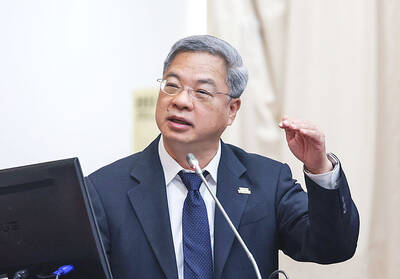CTi TV Inc’s hopes of regaining its footing in the cable news market were dashed yesterday after the National Communications Commission (NCC) rejected its plan to broadcast news on its variety channel.
The network on Jan. 29 filed an application to change CTi Variety’s business plan after the commission on Nov. 18 last year rejected CTi News’ application to renew its license, which expired in December.
At the same meeting in November, NCC commissioners approved CTi Variety’s license renewal on the condition that 75 percent of its programs must be made in Taiwan.
The network’s proposed business plan changes to the variety channel’s programming include adding one hour of news broadcasts in the morning, at midday and in the evening, as well as a one-hour political talk show.
However, the commission rejected the proposal on the grounds that a variety channel should primarily produce and broadcast variety shows and TV dramas.
“Last year, we approved CTi Variety’s license renewal application on the condition that it raise the percentage of programs made in Taiwan and increase its funding for the production of variety shows and TV dramas. The [variety] channel’s business plan should be different from that of news and entertainment channels,” NCC Deputy Chairman and spokesman Wong Po-tsung (翁柏宗) said.
“The proposed changes in CTi Variety’s business plan are incongruent with the conditions we set for its license renewal,” he said.
Wong added that CTi News’ license renewal application was rejected because its news department did not operate independently, with its largest shareholder — San Want Holding Ltd — constantly meddling in the newsroom.
“Based on the materials we reviewed, we believe that the variety channel’s internal control mechanism would not be able to shield the news team from undue interference from its largest shareholder,” he said.
In other news, the NCC also rejected Da Da Digital’s proposed acquisition of Taiwan Broadband Communications (TBC), saying that its largest shareholder should focus on reducing the debt ratios of five cable systems under TBC before reselling them.
Da Da Digital chairman Dai Yung-hui (戴永輝) in February last year acquired TBC by securing 65 percent of the shares of Asian Pay Television Trust — which owns TBC — from the trust’s only shareholder, Dynami Vision Pte cofounder Lu Fang-ming (呂芳銘).
The transaction was approved by the Fair Trade Commission on Nov. 4 last year and was awaiting final approval by the NCC.
Since Dynami secured ownership of TBC in 2017, the shareholding structure of the multiple-system operator has undergone several changes, the commission said.
Although Dynami promised to reduce debts incurred by five cable systems under TBC when it secured approval for the ownership change in 2017, a comparison of the five cable systems’ debt ratios last year with those published in 2017 shows little improvement, the NCC said, adding that in some cases, the debt ratios spiked rather than dropped.
“The current owner is seeking to transfer ownership [of TBC] before the cable systems have made any financial improvement. This shows that it views the cable systems only as objects for short-term sales and pays no heed to their long-term development. Approving such a transaction would harm the cable service industry,” the commission said.
Lu should aim to lower the cable systems’ debt ratios below 60 percent in three years, Wong said, citing a recent case adjudicated by the commission as a point of reference.

The Taipei Mass Rapid Transit (MRT) Wanda-Zhonghe Line is 81.7 percent complete, with public opening targeted for the end of 2027, New Taipei City Mayor Hou You-yi (侯友宜) said today. Surrounding roads are to be open to the public by the end of next year, Hou said during an inspection of construction progress. The 9.5km line, featuring nine underground stations and one depot, is expected to connect Chiang Kai-shek Memorial Hall Station to Chukuang Station in New Taipei City’s Jhonghe District (中和). All 18 tunnels for the line are complete, while the main structures of the stations and depot are mostly finished, he

The first global hotel Keys Selection by the Michelin Guide includes four hotels in Taiwan, Michelin announced yesterday. All four received the “Michelin One Key,” indicating guests are to experience a “very special stay” at any of the locations as the establishments are “a true gem with personality. Service always goes the extra mile, and the hotel provides much more than others in its price range.” Of the four hotels, three are located in Taipei and one in Taichung. In Taipei, the One Key accolades were awarded to the Capella Taipei, Kimpton Da An Taipei and Mandarin Oriental Taipei. Capella Taipei was described by

Minister of Economic Affairs Kung Ming-hsin (龔明鑫) yesterday said that private-sector refiners are willing to stop buying Russian naphtha should the EU ask them to, after a group of non-governmental organizations, including the Centre for Research on Energy and Clean Air (CREA), criticized the nation’s continued business with the country. While Taiwan joined the US and its Western allies in putting broad sanctions on Russia after it invaded Ukraine in 2022, it did not explicitly ban imports of naphtha, a major hard-currency earner for Russia. While state-owned firms stopped importing Russian oil in 2023, there is no restriction on private companies to

President William Lai (賴清德) is expected to announce a new advanced “all-domain” air defense system to better defend against China when he gives his keynote national day speech today, four sources familiar with the matter said. Taiwan is ramping up defense spending and modernizing its armed forces, but faces a China that has a far larger military and is adding its own advanced new weapons such as stealth fighter jets, aircraft carriers and a huge array of missiles. Lai is expected to announce the air defense system dubbed “Taiwan Dome” in his speech this morning, one of the sources said. The system